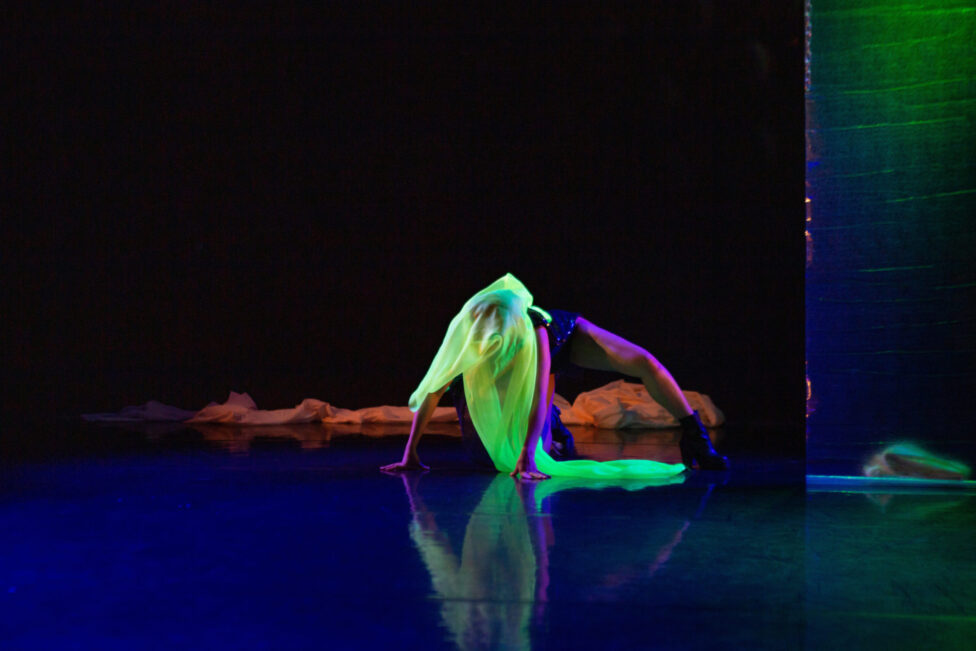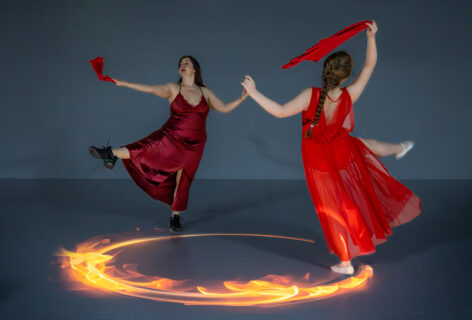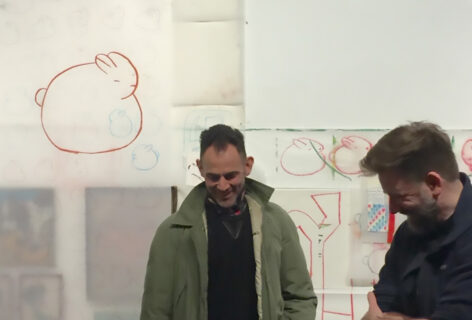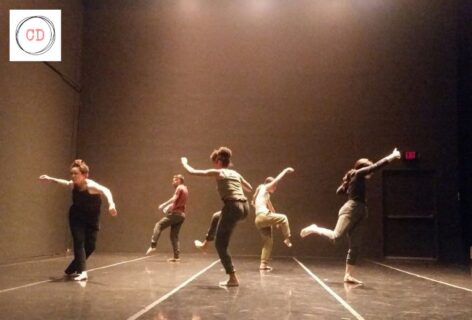She emerges from the darkness, wrapped in a gossamer white cloth that drapes up and over her head. She moves slowly, first placing one foot in front of the other and then melting to the floor. Nora pulls the fabric up and over their head, up and over, up and over. A yellow jumpsuit begins to peek through the folds of the cloth. Finally, the fabric’s end pools at their feet; she rises to her knees and crawls forward on the white fabric river, head bowed.
They stand; walk towards a small, folding table. She dresses the table, first with a yellow, patterned cloth, and then with books, trinkets, a glass, and a mug. A bottle of golden wine and a filled kettle emerge. Nora picks up a microphone; the kettle begins to boil.
My performance as an audience member is a ritual. I choose a seat in the middle back, preferably an aisle seat or against a wall so I can happily fidget, shift positions, and allow my eyes to wander. I bring layers of clothing as my body tends to dramatically fluctuate in temperature. I pre-emptively acknowledge my choreographic desires for deep stillness, an unflinching gaze, and audience participation to leave room for my senses to witness someone else and their ideas fully.
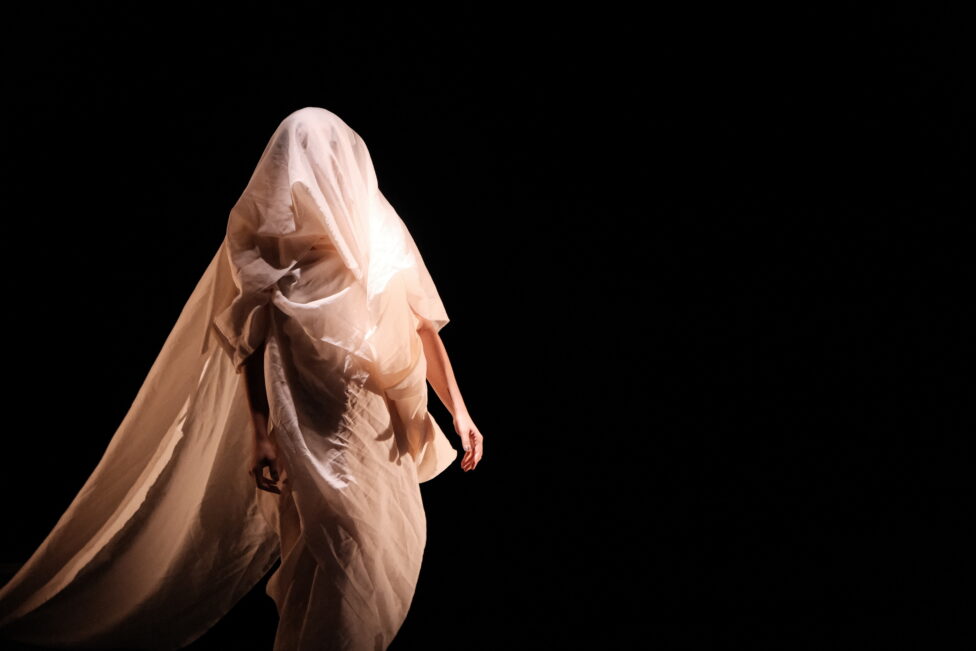
[ID: White light shines on a performer covered in layers of white sheer fabric that drapes behind them. Only their arms are visible from beneath the fabric.]
Photo of “The Eros Project” taken by Gabriel Molton
This iteration of my ritual (and by extension, this article) is in service of Nora Alami’s The Eros Project, a “multi-modal dance performance that triangulates desires, teases edges, and manipulates vantage points.” In the work, Nora seeks to find the moments of wanting–the eros or erotic– through vignettes of movement, musings, and installation interventions. For me, writing about Nora’s work is filled with its own kind of multifaceted erotic desire. How can I best represent a friend’s work while providing critical feedback? What about The Eros Project taps into my eroticism, asexuality, and the indescribable pull I feel towards live performance? And, how might I explore dance writing that reflects the multiple modalities expressed in Eros?
It is in this precipice of questions and emotions that I find my erotic self. Back in my seat at Triskelion Arts, I drop into my physicality. My pupils widen, my breathing slows as I sink into a place of rest and my brain whirls–massaged by mirror neurons that identify my bodily potential as I watch another move. When Nora describes the power of words in relationship to eros, she captures exactly how performance makes me feel as an audience member. “They raise the terrain on the skin to goosebumps… trace through the spine and shoot out all across the nervous system touching each and every nerve ending, mixing with the blood in the veins–circulatory.”
She is awash in vibrant red light. Nora grounds her feet and begins to shake, vibrate, and dance. The movement escalates, overwhelming their body. Pelvis rocks, head thrashes, hair swings.
One hand flies up and over her head, palm facing the audience. She’s breathless: “This all began with an infatuation with a coworker.”
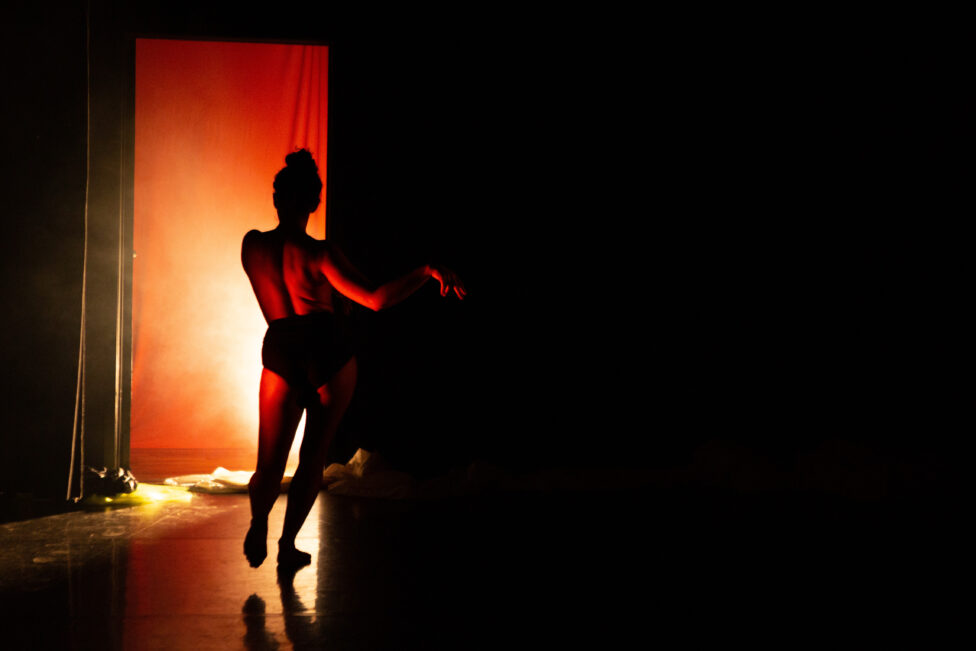
[ID: A dancer walks from a darkened stage into an orange doorway with white light shining through a sheer curtain. The light paints the dancer’s exposed body orange and casts shadows onto the curves of their back, arms, and legs.]
Photo “The Eros Project” taken by Julia Discenza
A response formulates in my head as I witness the start of Nora’s re-performed exchange. Asexuality, to me, is an opening, a magic portal that allows me to truly live in my body. My infatuation with queerness is life-saving.
Nora continues, “It was full of spacious flirting… he’d walk by and sometimes like trace his fingers along the bar. And I’d see it and we’d both know.”
I notice my hands wrapped around the paper program and think: I find eroticism in talking with my hands, in a mug of tea’s warmth radiating through a ceramic barrier, in scrambling up on all fours a rocky path that weaves between tall pines. I pleasure in the textures of life, running my fingers along corrugated, sappy bark instead of the polished veneer of a bar.
Nora sips her wine: “And so we go back to his place. And it’s my first time…I fell in love… with this apartment. It was full of… you could tell it got really nice natural light. It had big windows and figure drawings on the walls… plants hanging everywhere. I later find out that the plants belong to his other roommate.”
Expectation does not always match reality. I finally put all the pieces together when I learned that my friends experience physical attractions: when someone is pointed out as “hot,” one could actually get hot. My first reaction was that of concern. Surely then everyone would need to carry a sweater at all times. Perhaps my proclivity towards always stuffing a scarf in my bag was not that unusual after all.
Back to Nora: “He woke up nice and early [to write] the next morning… I got full range of his room. The coveted bookcase. I love creeping on people’s bookcases…On the second pass, I find this white book–thin–with red writing on the spine that says, Eros the Bittersweet. And I swear, it felt like a magic portal must have opened at that moment. And I even guessed maybe this book didn’t exist on that first pass, maybe it came on the second pass, specifically for me to find this text. I found out later he didn’t even finish the book, which I took as a sign about me and him. This… was about me and eros.”
Nora’s realization that the relationship she sought out that night was not in fact about the sex but instead about eros causes a bubble of laughter from my fellow audience members as the beginning beats of Mitski’s “Love Me More” rings out. Nora and I share a mutual love of Mitski and the throbbing of the song’s bass is the release I needed after Nora’s story. As they start to lip sync to the chorus… “I need you to love me more, love me more, love me more…” I realize this audience experience for me is not about any interpersonal relationship; it is about me and knowing my version of eros.
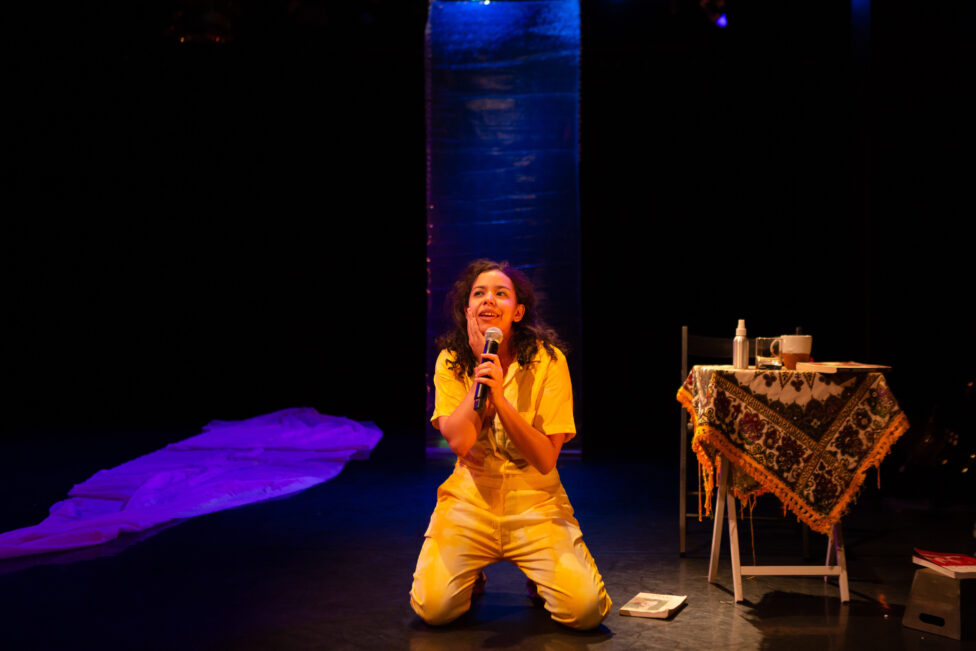
[ID: A performer holding a microphone sits on their knees while looking outwards and holding their face. There is a pool of purple light to their right and a folding table to their left. The table holds a patterned tablecloth, a spray bottle, a mug, a book, and a glass.]
Photo of “The Eros Project” taken by Julia Discenza
The Eros Project is a crafted balance of intimate, yet public, or as Nora puts it, “effusive [and] evasive” self-knowing. Nora practices her definition of eroticism and through that, I create and celebrate mine. Open conversations about eroticism occur with increasing frequency, and I am always grateful for the ongoing dialogue, especially as an ace person. I find hearing individual experiences, especially queer ones, to be healing and nourishing. I mirror Nora’s curiosities that drive her creative process, “what are the edges of ourselves and the edges of our desire?”
Nora and I begin to talk regularly over the phone. I ask them if I can write about the work.
As I begin to write, our phone calls/emails/texts lengthen. We build upon our existing intimacy as friends each time our voices meld. I explore “multimodal” writing. I queer my words, experiment with my practice of narrating audio descriptions, write performance descriptions, share my experiences, and allow for in-draft reflection. Nora writes me back at the bottom of my document; we co-accumulate our responses. She presses me further, pushing at the spaces of my desire and calling for my asexual eros to be made visible in the writing.
Nora: What is the texture of the space between eros and asexuality for you? Is there space?
What are the five senses of eros: what does it taste, smell, feel, look, [and] sound like? What do you wish we knew, was visible? What do you not want us to know (for yourself)? …If you could write a love letter, or scream into a void what would it be? Do you want to speak on the relationship between sexuality and asexuality?
What is the world of emotions that surface when I actually sit at the site of vulnerability? And what is it to do it with you?”
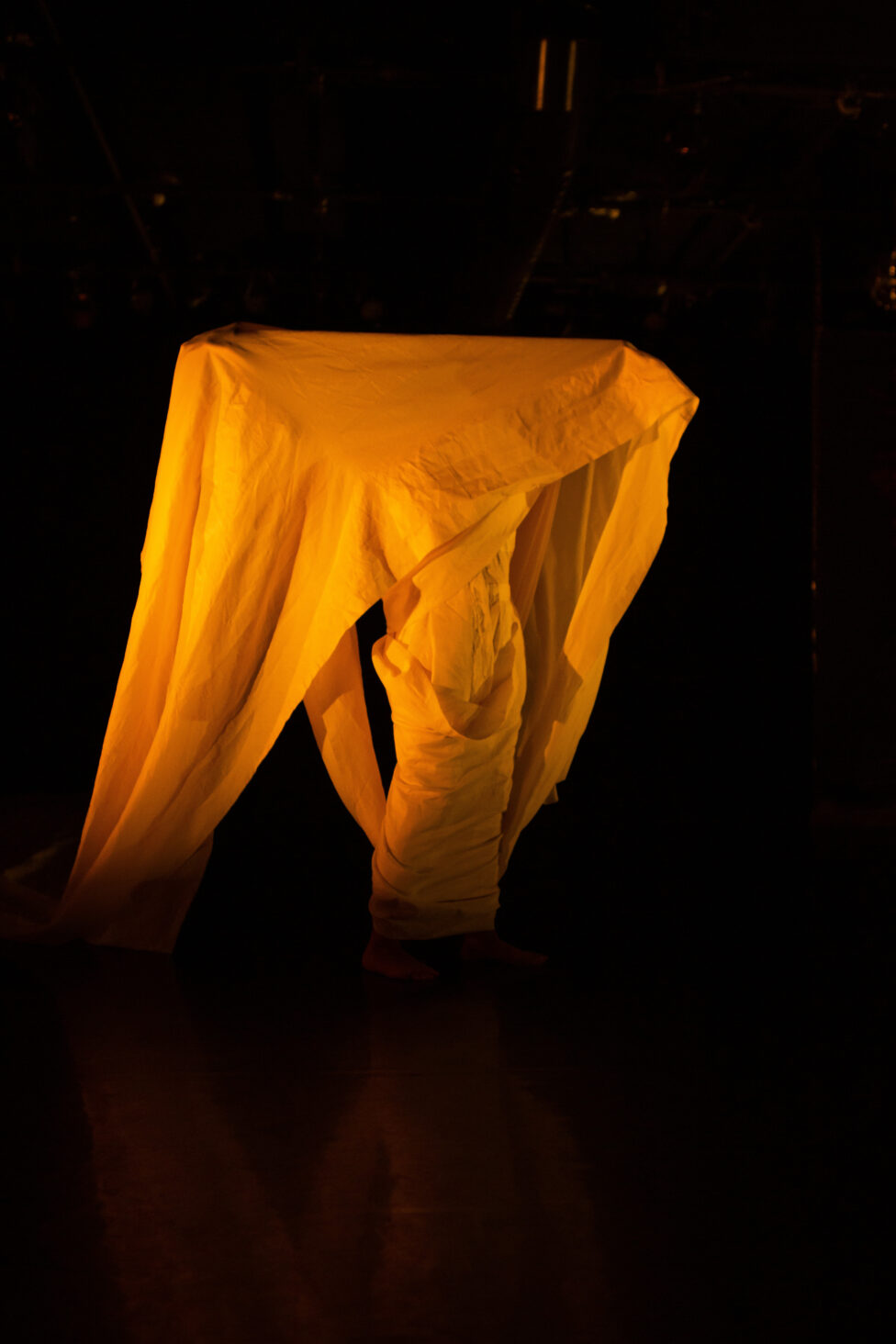
[ID: A performer bathed in yellow light and draped in white cloth stands with their arms extended upwards. The cloth falls over their arms and face. Only their feet are exposed.]
Photo of “The Eros Project” taken by Julia Discenza
It takes me a while to write openly about asexuality and my relationship with the erotic. I’ve spoken at length about being ace with friends, but writing for a public readership is challenging. I lean into my practice of writing about embodiment. Maybe I’m only equipped to write about performances I can hold at arm’s length, not ones that weave in between every facet of my personhood. Nora shares that while the Triskelion version of The Eros Project was fully produced, she is now returning to the process. She goes back into rehearsals and I return to my writing to edit, cut, and rearrange my thoughts and Nora’s notes.
Nora writes: Reading your descriptions of fragments of the work alone sends chills down my spine. It’s sort of dream-like to read the description and then visualize from a combination of the imagination your words conjure, my own embodied experiences, and the visualization from watching filmed footage.
They tell me I am clear and evocative, that this reflective writing helps her revisit the site of specific memories, but from my vantage point. She writes that she craves getting to listen to her friends uninterrupted and this writing feels like a gift. The exchange of pleasure is mutual. This reflexive, multi-vocal close reading of The Eros Project allows me to engage in a process of writing my asexual desires and then share the gift of intimacy with other queer or ace readers, writers, and/or makers.
This is my love letter to asexuality and live performance. Nora and I plan to sustain our relationship as thought partners as she continues to develop The Eros Project. This article is one iteration of our work: a commitment to sit in the vulnerability of creation, together. This is queer eros. The feeling is visceral and it radiates warmth through my body and my veins–circulatory.

